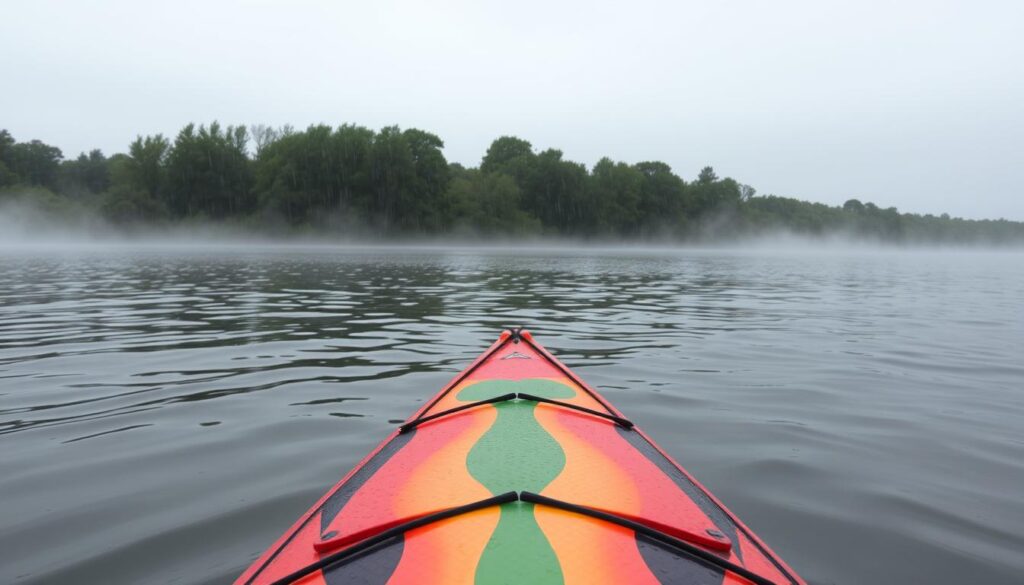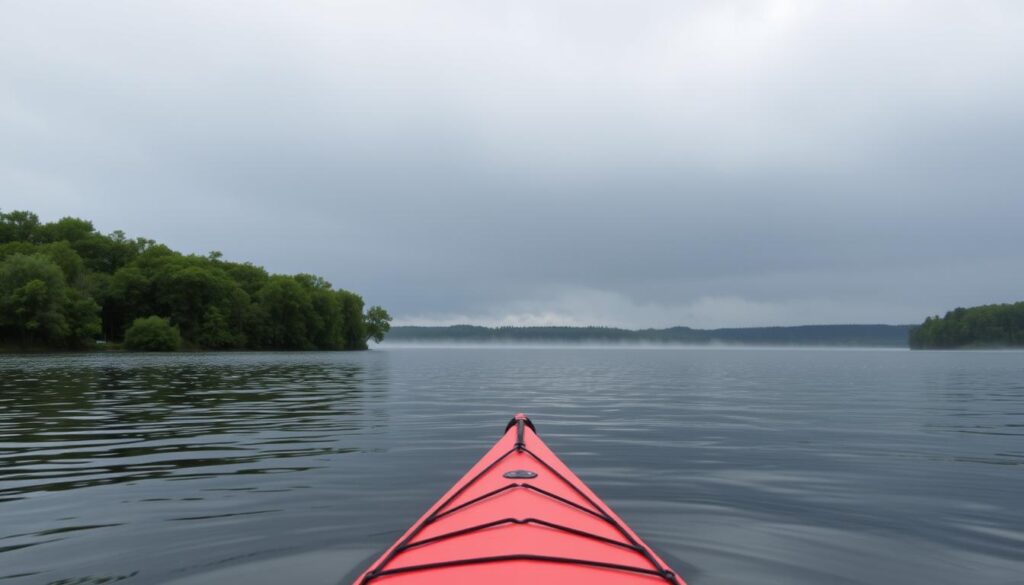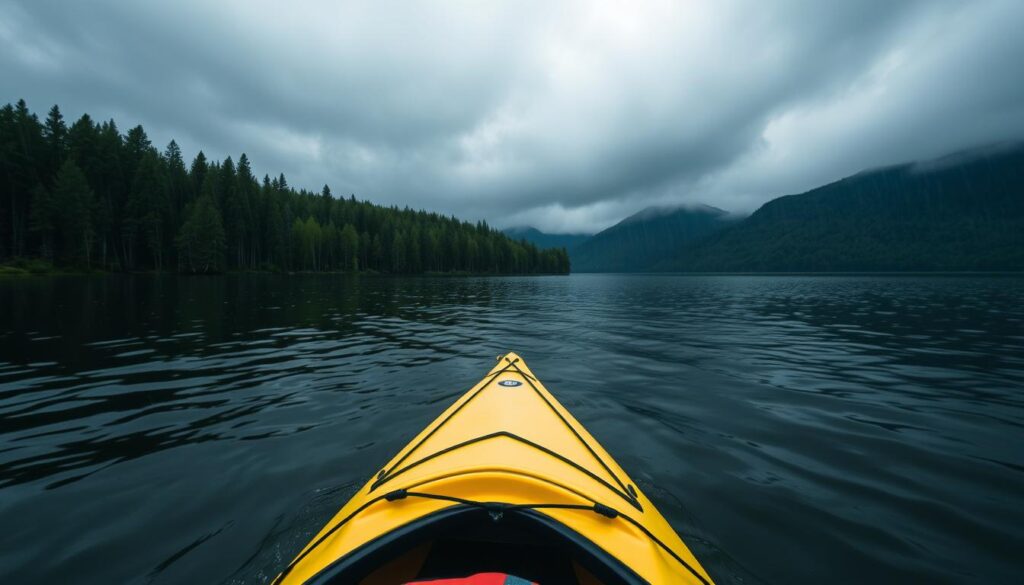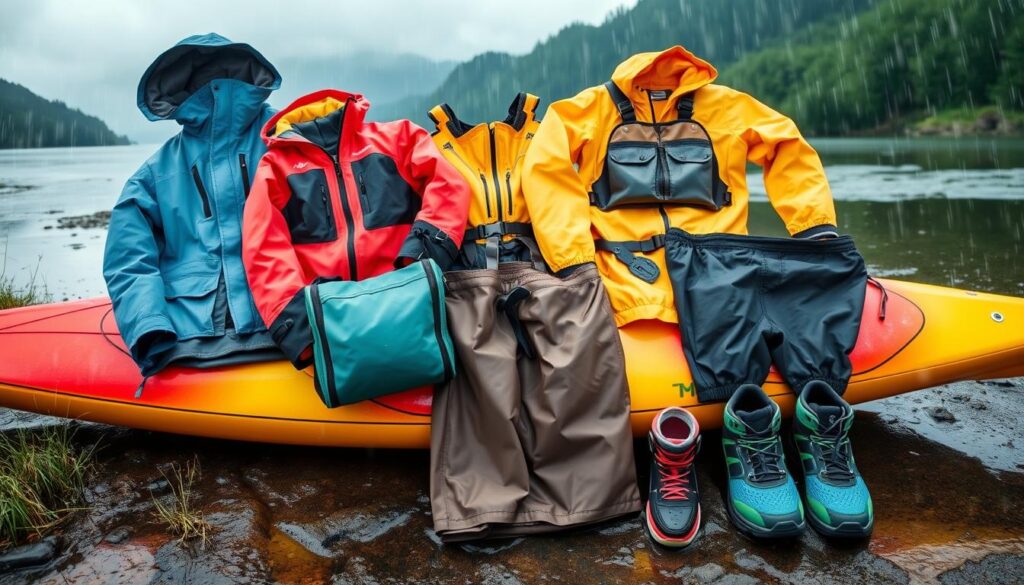- Key Takeaways
- Understanding Weather Conditions for Safe Kayaking
- Can You Kayak in the Rain: Safety Guidelines and Considerations
- Essential Wet Weather Kayaking Gear
- Choosing the Right Kayak for Wet Weather Paddling
- Proper Techniques for Paddling in Rain
- Common Challenges of Kayaking in Rainy Conditions
- Water Temperature Considerations During Rainfall
- Emergency Preparedness for Wet Weather Kayaking
- Conclusion
- FAQ
- Is it safe to kayak in the rain?
- What essential gear do I need for kayaking in wet weather?
- How can I protect myself from hypothermia while kayaking in the rain?
- What weather conditions should I avoid when kayaking?
- How do I maintain visibility while kayaking in the rain?
- What emergency preparations should I make before kayaking in rainy conditions?
- Can rain affect my kayak’s performance?
- How do I choose the right kayak for wet weather paddling?

Many paddling fans wonder, can you kayak in the rain? The short answer is yes! Kayaking in the rain can be a thrilling adventure if you’re properly prepared. However, it comes with unique challenges, so it’s crucial to prioritize safety and bring the right gear.
Rainy weather doesn’t have to cancel your plans. With the proper precautions, you can enjoy paddling in wet conditions while staying safe and comfortable. This guide answers the question, “Can you kayak in the rain?” and offers essential tips to make your trip enjoyable.
Key Takeaways
- Rain doesn’t prevent kayaking with proper preparation
- Safety should always be your primary concern
- Specialized gear is essential for wet weather paddling
- Weather forecasts are critical before launching
- Understanding water temperature helps prevent hypothermia risks
- Can you kayak in the rain? Yes, with preparation and the right safety measures.Safety should always be your top concern when paddling in the rain.Specialized gear and understanding weather conditions are essential.
Understanding Weather Conditions for Safe Kayaking
Kayaking in the rain needs careful planning and knowing the weather. Your safety depends on understanding the weather well. To paddle safely in wet weather, you need to know the weather and plan ahead.

Knowing the weather is key for safe kayaking in rain. Different kinds of rain can change your paddling experience and risks.
Can you kayak in the rain safely? Absolutely, but it requires a solid understanding of weather patterns. Before heading out, always check the forecast and plan your trip accordingly.
Rain Classifications and Their Impact
- Light Drizzle: Minimal effect on your trip.
- Moderate Rain: Slightly reduced visibility and choppy waters.
- Thunderstorm Rain: Extremely unsafe—avoid paddling.
To answer “can you kayak in the rain,” consider how different types of rainfall affect your route.
Rain Classification for Kayakers
- Light Drizzle: Minimal impact on kayaking conditions
- Moderate Rain: Reduced visibility and potential surface choppiness
- Thunderstorm Rain: Extreme danger, immediate water exit recommended
Forecast Reading Strategies
Reading weather forecasts is more than just looking at rain chances. For safe kayaking in rain, you need to look at several weather factors:
| Weather Factor | Kayaking Impact | Safety Recommendation |
|---|---|---|
| Wind Speed | Wave Height Increase | Avoid paddling above 15 mph winds |
| Temperature | Hypothermia Risk | Check water temperature, wear proper gear |
| Storm Potential | Electrical Hazard | Cancel trip if thunderstorms predicted |
Dangerous Weather Pattern Recognition
It’s important to spot dangerous weather patterns for safe kayaking. Look out for sudden weather changes, fast-growing clouds, and unexpected wind shifts. Kayak experts say always have a backup plan and be ready to get out of the water fast.
“In kayaking, respect the weather—it can change faster than you can paddle.” – Professional Kayak Instructor
By knowing these weather tips, you’ll stay safe and have fun kayaking in the rain.
Can You Kayak in the Rain: Safety Guidelines and Considerations
Kayaking in the rain comes with its own set of challenges. Safety should always be your top priority. Not all rainy days are the same, and knowing the risks is key to a safe trip.
When you ask, can you kayak in the rain, safety is the first factor to address. Take the following precautions:

- Check local weather forecasts thoroughly
- Assess water conditions and potential visibility issues
- Inform someone about your kayaking route and expected return time
- Carry reliable communication devices
“Preparation is the key to safe kayaking, especially in challenging weather conditions.” – Professional Kayaking Association
When kayaking in the rain, visibility is a big deal. Less light and water can hide dangers. Wear bright clothes and make sure your kayak is well-lit to be seen by others.
Water levels can change a lot in the rain. This can make currents stronger or bring in debris. Always check your route before you go and be ready to change plans if it’s not safe.
Your own risk assessment should look at:
- Wind speed and direction
- Rain intensity
- Water temperature
- Potential storm developments
It’s sometimes best to wait for a better day to kayak. Your safety is more important than any adventure when the weather gets too bad.
Essential Wet Weather Kayaking Gear
When kayaking in the rain, you need special gear to stay dry and safe. The right gear helps you enjoy your trip, no matter the weather.

Waterproof Clothing Options
Choosing the right rain jacket and drysuit is key. Your clothes should:
- Kayaking rain jacket with sealed seams
- Waterproof kayaking rain pants
- Kayaking rain poncho for extra coverage
- Neoprene or waterproof gloves
Navigation Tools for Limited Visibility
Visibility drops in the rain. You’ll need:
| Tool | Purpose |
|---|---|
| Waterproof GPS | Track location and route |
| Compass | Maintain directional awareness |
| Bright LED headlamp | Enhance visibility |
Safety Equipment for Rainy Conditions
Always put safety first with your gear. Make sure to carry:
- Waterproof emergency communication device
- Bilge pump to remove water
- Spray skirt to prevent water entry
- Waterproof storage containers
“Proper gear transforms a potentially miserable rainy kayaking experience into an enjoyable adventure.” – Professional Kayaking Instructor
Investing in quality wet weather kayaking gear ensures you stay safe, dry, and comfortable on the water.
Choosing the Right Kayak for Wet Weather Paddling
Choosing the right kayak for rainy weather is key. It affects your safety and fun on the water. Think about what you need before picking a kayak.
There are kayaks made for rainy days. Sit-on-top kayaks drain water fast and are easy to flip back over. Sit-inside kayaks keep you dry in light rain and protect you from the elements.
- Material Considerations:
- Polyethylene: Durable and affordable
- Composite materials: Lightweight and responsive
- Inflatable kayaks: Portable but less stable in rough conditions
“The right kayak can transform a rainy day from a challenge into an opportunity for adventure.” – Professional Kayaking Instructor
Look for these features in a kayak for rainy weather:
- Stability in choppy waters
- Effective water drainage systems
- Sealed storage compartments
- Comfortable seating with water-resistant padding
Modern kayaks for rainy days have cool features. They have self-bailing holes, better hull designs, and track well. Choose a kayak that fits your skill and local waters for a safe, fun trip.
Proper Techniques for Paddling in Rain
Kayaking in wet weather requires extra skill. For those asking, can you kayak in the rain safely, practicing these techniques is key:
- Wear a brimmed hat to shield your eyes from rain and maintain visibility.
- Keep a low center of gravity for stability.
Maintaining Visibility and Control
To see better in the rain, you need to prepare:
- Wear a waterproof hat with a wide brim to shield your eyes
- Use anti-fog treatments on eyewear
- Invest in high-visibility clothing with reflective elements
- Carry a waterproof headlamp for additional visibility
Handling Wind and Choppy Waters
Dealing with windy and rough waters needs special paddling:
- Lower your center of gravity for better stability
- Use shorter, more controlled paddle strokes
- Angle your kayak slightly into incoming waves
- Maintain a relaxed but firm grip on your paddle
Managing Water Entry into Your Kayak
Keeping water out is crucial during rainy kayaking:
| Technique | Description | Effectiveness |
|---|---|---|
| Spray Skirt | Seals cockpit opening | High |
| Bilge Pump | Removes accumulated water | Medium |
| Proper Seating | Minimizes water collection | Low-Medium |
“Preparation transforms challenging conditions into exciting kayaking experiences.” – Professional Kayaking Instructor
Remember, practice and preparation are key to successfully kayaking in rainy conditions. Stay safe, stay alert, and enjoy the unique adventure!
Common Challenges of Kayaking in Rainy Conditions
Kayaking in the rain comes with its own set of challenges. The biggest one is reduced visibility. This makes it hard for paddlers to see where they’re going. Rain also changes the water, making it important to know the risks and how to handle them.When people ask, can you kayak in the rain, they often overlook challenges like reduced visibility and water turbulence.
- Decreased water clarity
- Increased water turbulence
- Potential flash flooding risks
- Limited visual perception
Before you start kayaking in the rain, get mentally ready. Weather can change fast, so you need to stay alert and flexible. Water levels can go up quickly, making the currents harder to handle.
“Preparation is the key to safe and enjoyable kayaking in challenging weather conditions.”
Wind and rain make paddling tricky. You need to adjust your technique to:
- Maintain the right stroke
- Keep water out of your kayak
- Stay on course in rough waters
| Challenge | Impact | Recommended Action |
|---|---|---|
| Visibility | Reduced navigation clarity | Use bright clothing, reflective gear |
| Water Turbulence | Increased paddling difficulty | Adjust paddling technique, stay calm |
| Temperature | Potential hypothermia risk | Wear appropriate thermal layers |
Kayaking in rainy conditions requires skill, preparation, and respect for nature’s changes.
Water Temperature Considerations During Rainfall
Kayaking in the rain means you need to watch the water temperature closely. This is to avoid getting too cold. Knowing how rain changes the water helps you stay safe and have fun.
Cold water is a big challenge for kayakers, especially when it rains. Your body loses heat faster in water than in air. So, it’s very important to be careful when kayaking in the rain to stay alive.
Understanding Hypothermia Risks
Hypothermia happens when your body temperature goes below 95°F. To stay safe in the rain, watch for these signs:
- Uncontrollable shivering
- Slurred speech
- Lack of coordination
- Confusion or drowsiness
Protective Measures Against Cold Water
To stay warm, you need to prepare and use the right gear. Here are some key tips for kayaking in the rain:
| Protection Method | Effectiveness |
|---|---|
| Wetsuit or Drysuit | High |
| Thermal Base Layers | Medium |
| Neoprene Gloves | High |
| Waterproof Headwear | Medium |
Pro tip: Always carry emergency thermal blankets and know how to quickly exit the water if temperatures become dangerous.
“Preparation is the key to survival in cold water kayaking conditions.” – Professional Kayak Instructor
By knowing about water temperature and taking the right precautions, you can lower the risk of hypothermia. This makes your kayaking trip safer and more enjoyable.
Emergency Preparedness for Wet Weather Kayaking
Kayaking in rainy weather needs careful planning. Your safety depends on being ready and quick to act in unexpected situations.
Creating a detailed emergency plan is key when kayaking in the rain. Being prepared can turn a bad situation into a manageable one.
- Develop a detailed float plan with trusted contacts
- Carry multiple communication devices
- Pack a waterproof emergency kit
- Learn essential self-rescue techniques
When kayaking in the rain, having reliable ways to communicate is vital. Use waterproof marine radios and satellite devices to stay connected when phones don’t work.
| Emergency Item | Purpose | Recommended Type |
|---|---|---|
| Personal Locator Beacon | Emergency Signaling | EPIRB-compatible device |
| First Aid Kit | Medical Treatment | Waterproof, compact version |
| Emergency Shelter | Protection from Elements | Lightweight emergency bivvy |
“Preparation is the key to survival in challenging kayaking conditions.” – Expert Kayak Safety Instructor
Practice safety drills often to be ready for emergencies. Knowing how to handle capsizing and bad weather can save your life.
- Take wilderness first aid courses
- Practice self-rescue techniques
- Understand hypothermia prevention
Remember, no adventure is worth risking your life. Always prioritize safety when kayaking in wet and challenging conditions.
Conclusion
Kayaking in the rain is both challenging and exciting for outdoor lovers. With the right preparation, you can enjoy a new level of paddling adventure. It’s all about knowing your limits, checking the weather, and keeping safety in mind.
Planning and choosing the right gear are crucial for kayaking in the rain. Using waterproof equipment and understanding the weather can make your trip thrilling. Always put your safety first when exploring wet and unpredictable waters.
For experienced kayakers, paddling in the rain tests your skills and mental toughness. Learning about weather, picking the right gear, and being ready for emergencies can improve your abilities. Each rainy trip is a chance to learn and push your limits.
Keep learning and practicing. Look for lessons from expert kayakers, join local groups, and stay up-to-date with safety tips. Your journey in mastering kayaking in different weather is a continuous learning and growth experience.
So, can you kayak in the rain? Yes, you can! With the right preparation, gear, and techniques, paddling in wet weather can be an exhilarating experience. Always prioritize safety and respect nature’s unpredictability.
FAQ
Is it safe to kayak in the rain?
Kayaking in the rain can be safe if you’re careful. Check the weather, wear waterproof gear, and have safety equipment. Don’t kayak in thunderstorms, heavy rain, or strong winds.
What essential gear do I need for kayaking in wet weather?
You’ll need a waterproof jacket, rain pants, and a drysuit. Also, bring waterproof bags, a spray skirt, and navigation tools. Don’t forget a bilge pump, extra clothes, and waterproof devices.
How can I protect myself from hypothermia while kayaking in the rain?
Wear thermal layers, a drysuit or wetsuit, and extra clothes. Keep an eye on your body temperature and avoid cotton. Carry emergency warming supplies and check water temperatures.
What weather conditions should I avoid when kayaking?
Stay away from thunderstorms, severe winds, and flash flood warnings. Also, avoid low visibility and sudden weather changes. Always check the weather forecast before you go.
How do I maintain visibility while kayaking in the rain?
Wear high-visibility clothes and reflective gear. Use waterproof lights and bright colors. This helps you be seen in low light.
What emergency preparations should I make before kayaking in rainy conditions?
Make a float plan and tell someone your route and return time. Carry a waterproof phone and an emergency kit. Practice self-rescue and bring first aid, signaling devices, and extra food and water.
Can rain affect my kayak’s performance?
Rain can make waters choppy and visibility poor. It can also change water levels. Choose a stable kayak and adjust your paddling as needed.
How do I choose the right kayak for wet weather paddling?
Look for a kayak with stability, sealed compartments, and good drainage. Sit-inside kayaks are often better in rain. Consider durability, weight, and your paddling area.

